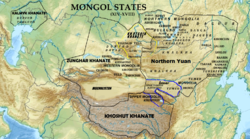Khoshut Khanate
| Khoshut Khanate | ||||||||||
| State of Khoshut Quoshote Khanate 和硕特汗国 |
||||||||||
| Nomadic empire | ||||||||||
|
||||||||||
|
Location of the Khoshut Khanate
|
||||||||||
| Capital | Not specified | |||||||||
| Religion | Tibetan Buddhism | |||||||||
| Government | Monarchy | |||||||||
| History | ||||||||||
| • | Established | 1642 | ||||||||
| • | Disestablished | 1717 | ||||||||
| Area | 1,400,000 km² (540,543 sq mi) | |||||||||
|
||||||||||
| Today part of |
|
|||||||||
The Khoshut Khanate was an Oirat khanate based in the Tibetan Plateau in the 17th and the 18th centuries. It was established in 1642 by Güshi Khan, a Khoshut prince and leader of the Upper Mongols. He was enthroned by the Dalai Lama as Khan and protector-ruler of Tibet. With Güshi Khan as a largely uninvolved overlord, the 5th Dalai Lama and his intimates established a civil administration which is referred to by historians as the Lhasa state. This Tibetan regime or government is also referred to as the Ganden Phodrang. The Khoshut Khanate was conquered by the troops of the Dzungar Khanate in 1717, who deposed Yeshe Gyatso, a pretender to the position of the Dalai Lama promoted by Lha-bzang Khan, the last ruler of the Khoshut Khanat. The Dzungars were in turn expelled by the expedition forces of the Qing dynasty from Tibet in 1720.
...
Wikipedia

